Color is an essential part of how we experience the world. But do colors really matter for conversions?
Everything in our world is made up of things that are of various color. Different colors can lift us up, or bring us down. There is also a psychological side to colors – certain colors are said to be associated with different qualities and emotions. Can come colors make our website convert better?
In different cultures different colors can mean contradicting things. For example, white is the color of mourning and death in Chinese culture, but the color of death in Brazil is purple. Yellow is sacred to the Hindus, but represents sadness in Greece and jealousy in France. In North America, green is typically associated with jealousy. People from tropical countries respond most favorably to warm colors; people from northern climates prefer the cooler colors and so on.
It’s said that in North-American culture the color blue creates feeling of trust, but also encourages appetite. Green supposedly means nature, freshness, growth and money. Yellow brings with it sun and sunshine plus happiness.
For sure there is some truth to all of this, but can we translate this to lifting conversions?
Experiments with color usage
Red can make you a winner
Almost universally, red means stop. Red means danger. Red means hot. And analyzing the results in the 2004 Olympics, researchers have found that red also means dominance.
They examined boxing, taekwondo, Greco-Roman wrestling and freestyle wrestling, basically all of the one-one-one sports in the 2004 Olympics. In those sports competitors are randomly assigned red or blue outfits, so no rigging is possible.

In 16 of 21 rounds those wearing red won. Similar tendencies were found in the 2004 European Soccer Championship. Researchers are careful to point out that the effect is subtle at best. And that red can be deciding factor only among evenly matched competitors – but it still exists.
“We find that wearing red is consistently associated with higher probability of winning,” University of Durham researchers Russell Hill and Robert Barton write.
… and a loser
Researchers at the university of Rochester have found that the color red can also keep us from performing our best on tests. In their experiments they wanted to find out if the perception of red will have any effect on results of important tests such as an IQ test or a major academic exam. In academic context color red is traditionally associated with marking errors on school papers.
Results
Four experiments that they carried out showed that just a brief perception of the color will have negative impact on the results. “It leads people to do worse without their knowledge,” says Elliot (one of the authors), when it comes to academic achievement.
The findings show that “care must be taken in how red is used in achievement contexts,” the researchers reported, “and illustrate how color can act as a subtle environmental cue that has important influences on behavior.”
Color and the taste of hot chocolate

Turns out that the color of the container where the food and drink is served contributes to the aroma and taste of your food and drinks. That is conclusion in the case of drinking hot chocolate explains Betina Piqueras-Fiszman, researcher at the Polytechnic University of Valencia (Spain). Along with her colleague Charles Spence, from the University of Oxford (UK).
The experiment
The experiment involved 57 participants in where they had to evaluate samples of hot chocolate served in four different colors (white, cream, orange and red) of plastic cups. They were all the same size, and all of them white from the inside.
Results
Results reveal that the flavor of hot chocolate served in orange and cream colored cups was judged better by the participants. However, the sweetness and the aroma was judged to be in the same lines in all the cups no matter the color.
“There is no fixed rule stating that flavor and aroma are enhanced in a cup of a certain color or shade,” recognized Piqueras-Fiszman. “In reality this varies depending on the type of food, but the truth is that, as this effect occurs, more attention should be paid to the color of the container as it has more potential than one could imagine.”
In other experiments it has been demonstrated that strawberry mousse appears to be sweeter and more intense on a white plate compared to a black one.
Best color for buttons
This is all well and good to know that red might just make your chances of winning in sports better and that hot chocolate tastes better in a certain color cup but what has this anything to do with conversions on the web? Does red, really, give an advantage in conversion?
Green vs red button war
There has been something of a controversy going around in the interwebs about which button color converts better. Unbounce declared that the future of call-to-action buttons is BOB. That stands for Big Orange Button.
There’s a number of interesting A/B testing case studies where orange, in our case mostly red, button was up against competition from various other colors including green.
When you think about then green is mostly associated with positive emotions. When the traffic lights turn green it means you can drive. Vice-versa with red. That color is mostly associate with negative emotions. With traffic lights example when the lights turn red you stop.
So what you think?
Which one wins. Green or red, red or green? Read the following case studies and find out.
Case study 1

Dmix writes about about one of their projects in which they tested green and red button colors. In their testing with 600 subjects they found that conversions increased by 34% when they used red button.
34% is a decent lift in conversion. 1:0 for red buttons.
Case study 2
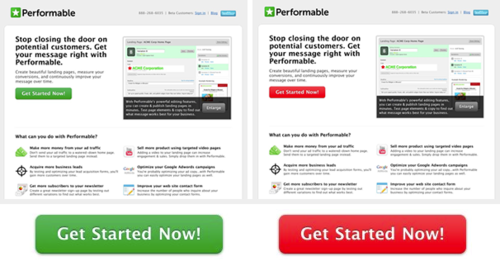
Next test comes courtesy of HubSpot. They ran similar test with green and red buttons on one of their clients web page. They ran the test over a period of a few days worth of traffic and in total had over 2000 subjects visit.
Their result was that red button outperformed green button by 21%. 2:0 to red button.
Case study 3
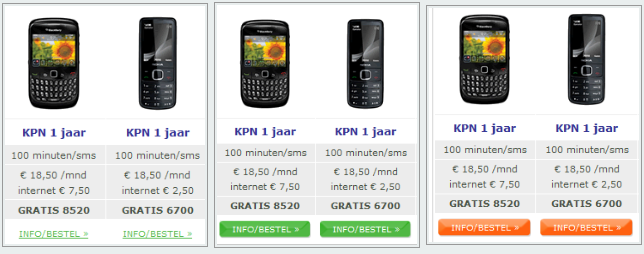
Third test comes courtesy of Visual Website Optimizer. Their client was an eCommerce site selling mobile phones and accessories. They tested Buy Now button colors on their site. In competition were white button with green text, green button with white text and red (darker orange) button with white text.
And the winner was… You guess it – it was the red button, this time with 5% better conversion. 3:0 for the red button
Case study 4
![]()
So far we’ve seen total dominance by the red button. So let’s change things up. This time lets see how it does against a blue button courtesy of Monetate. In their tests, surprisingly, the blue button won by producing a 9% lift. It might have been an anomaly, something must have been wrong with that test…
Anyhow, the final results are that red button wins 3:1. It’s safe to say that, based on various A/B testing, the best color for call-to-action buttons is RED! Yay, victory…
Or is it?
Didn’t Peep write the following about colors in web design in this post:
I liked this tweet by Naomi Niles:
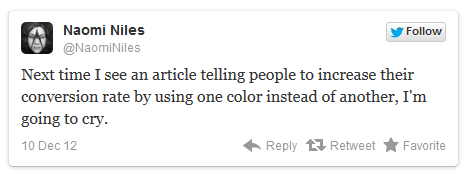
I couldn’t agree more. This kind of narrative gives people the wrong idea about what testing is about. Yes sure – sometimes the color affects results – especially when it affects visual hierarchy, makes the call to action stand out better and so on. But “green vs orange” is not the essence of A/B testing. It’s about understanding the target audience. Doing research and analysis can be tedious and it’s definitely hard work, but it’s something you need to do.
In order to give your conversions a serious lift you need to do conversion research. You need to do the heavy lifting.
Serious gains in conversions don’t come from psychological trickery, but from analyzing what your customers really need, the language that resonates with them and how they want to buy it. It’s about relevancy and perceived value of the total offer.
The last cast study
Let’s take a look at one last example which will make all of this make whole lot more sense. RIPT Apparel tested color of their buy now button to see if it makes any difference to their bottom line.
This is the original version:
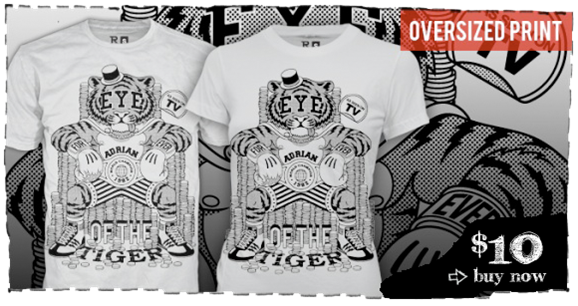
And this the new button:
To no great surprise, conversion numbers went up. Now looking at the previous cases one could say that if they changed the button to red it would convert even better.
Well, not quite.
Take a look at the original again, do you see anything weird. Or something that should be there but isn’t?
Missing button
The original is missing a button! The “Buy Now” call-to-action simply gets lost in the design – you can’t see it. With the new button you can clearly see it, color makes little to no difference. And this, unfortunately, is how the great controversy of red/orange buttons got started. You look at those tests and results and you see amazing results that tell you that this color or that color converts the best.
That is, until you look closer. More often than not they reveal something similar e.g. there was no previous button or the button is just so much more prominent, it stands out from the rest of the page and thus converts way better.
Monetate (authors of the blue vs orange button test) write this about it:
But, if you dig into the results, you’ll see that orange buttons were almost always tested against a control of no button at all. In cases like these, it’s hardly a surprise that orange buttons make a difference. Of course they do … when compared to no button at all! Practically any button will make a difference, regardless of color.
In the case of RIPT Apparel, they tested one last final version – this time a yellow one:
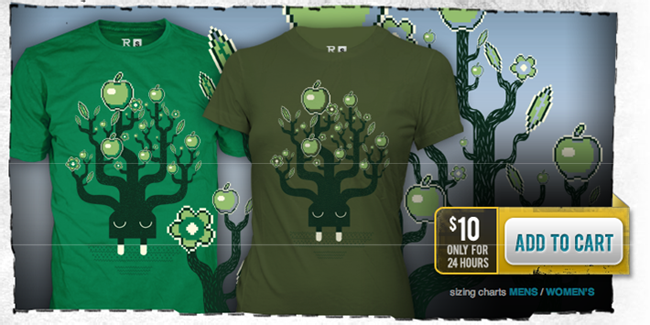
With the latest test conversions went up a further 6.3%. So yellow beats green? No, no, no.
Color makes little difference on its own
The color of the button has little to no effect on it’s own. What is more important is how it changes the visual hierarchy of the whole page, how it makes the call-to-action stand out. Plus additional information and wording of the button itself.
It’s also what we’re used to. Bing increased their revenue by $80 million dollars by finding the exact color of blue for their links. Why is that? It’s because people are used to links being blue. When WWW first came to be, blue was the color of links. Microsoft engineers working on this also admitted this: “…it was a shade of blue quite similar to the one used by Google.”
There is no best color for web pages that makes them convert better. I’ll say that again: there is NO best color for conversions.
In the yellow button’s case, they also added emphasize of time limitation ($10 only for 24 hours) to the button which has been demonstrated time and time again to lift conversions. In the case of Bing and blue, it was the power of convention in action.
Back to HubSpot
The same can be said for the HubSpot’s example. Take a look at it again:
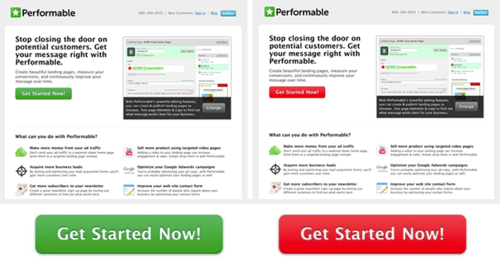
Look at the original green one on the left and the new red one. Do you notice anything that might contribute to the red button being a better choice? Something in the overall design of the page?
Something like – oh I don’t know – using green as one of the main colors on the site? Bingo! Green is the dominant color on the whole page. And what happens when you add a green button to the mix?
It won’t stand out! They could have tested it against pretty much any other bright color and would have seen the same kind of “amazing” conversion results.
To HubSpot’s credit they to say in the case study that they “cannot generalize these results to all situations. The most we can say is that they hold for the conditions in which they occurred: in this page design, on this site, with the audience that viewed it.” But still, green button on a page with dominant green design, really?
Conclusions
Color usage does matter, sometimes a lot. But saying that one color converts better than another is simply stupid. There is no universal best color. What works on one site, doesn’t necessarily work on another.
Visual hierarchy matters and making your call to actions stand out matters. So “green vs red” is not so much about the color, but “does the important stuff stand out enough” and if not, how can we improve the situation.
Post by Ott Niggulis

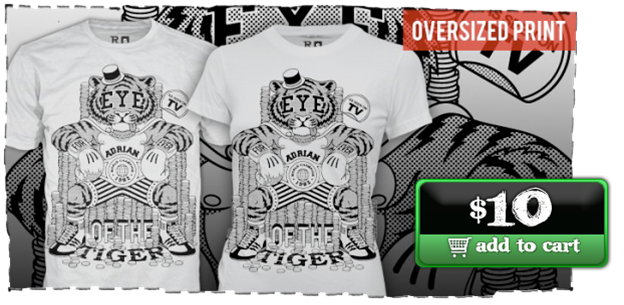 Image credit
Image credit